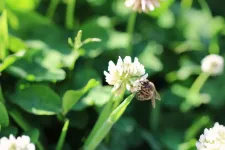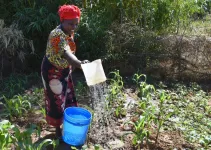(Press-News.org) DALLAS, Jan. 14, 2021 -- The longer the time between when heart attack symptoms start and a patient has an artery-clearing percutaneous coronary intervention (PCI), the more damage to the heart muscle, according to new research published today in Circulation: Cardiovascular Interventions, an American Heart Association journal.
A heart attack happens about every 40 seconds in the U.S., and the most common heart attack is caused by a complete blockage in a coronary artery, called ST-elevation myocardial infarction (STEMI). STEMI patients are most often treated with PCI, also known as angioplasty with stent, in which a catheter with a deflated balloon is inserted into the narrowed heart artery. Subsequently, the balloon is inflated, which clears the obstruction and restores blood flow. A stent is then inserted to keep the artery open.
"We know the time to opening the blocked coronary artery with PCI in heart attack patients is an important indicator for how a patient does after their heart attack. There are two measures for this time. One is symptom-to-balloon time, which is before the patient arrives to the hospital after symptoms start, to when that patient has a PCI; second is door-to-balloon time, the time from hospital arrival to PCI," said study author Gregg W. Stone, M.D., director of academic affairs at Mount Sinai Heart Health System in New York City. "We focused on heart attack size, or damage, with both time measures and found symptom-to-balloon time was by far the more important."
Stone and colleagues analyzed the data from 10 randomized controlled trials that followed more than 3,100 STEMI patients enrolled after PCI between 2002-2011. Patients' hearts were assessed within between 3-12 days after PCI to measure the size of the heart attack, and some studies also included measures of ejection fraction (a measure of the percentage of blood the heart is able to pump with each contraction) and TIMI flow (a measure of blood flow in the coronary artery). All patients had clinical follow-up data for at least six months, with a median follow-up of 341 days after PCI.
The study found:
Symptom-to-balloon time was more strongly associated with heart attack size and patients' clinical health after heart attack than door-to-balloon time.
The median symptom-to-balloon time was 185 minutes. The median door-to-balloon time was 46 minutes.
Symptom-to-balloon time represented approximately 80% of the total time from symptom onset to treatment of the artery.
The size of the heart attack increased with longer symptom-to-balloon times, whereas longer door-to-balloon times were not notably related to heart attack size.
Older age, female sex, arterial hypertension, diabetes and left circumflex artery as the culprit vessel were associated with longer symptom-to-balloon time.
For every 60-minute delay in symptom-to-balloon time, the one-year rate of death or hospitalization for heart failure was increased by 11%. In contrast, there was no relationship between delays in door-to-balloon time and these clinical results.
"Health care teams have worked to reduce door-to-balloon times and are achieving excellent results with a median time of 46 minutes. While we shouldn't become complacent and relax our current standards of rapidly performing PCI as soon as possible after the patient reaches the hospital, this study suggests that major efforts to further shorten door-to-balloon times by 10 or 20 minutes might not translate to better PCI outcomes," Stone said. "Our analysis indicates the more important and meaningful focus should be to shorten the delays from symptom onset to arrival at hospitals that can perform PCI. We must emphasize efforts to increase public awareness of heart attack symptoms and shorten the time it takes for patients to access emergency care."
These findings are extremely important and particularly relevant right now, said American Heart Association president Mitchell S.V. Elkind, M.D., M.S., FAHA, FAAN, professor of neurology and epidemiology at Vagelos College of Physicians and Surgeons and attending neurologist at New York-Presbyterian/Columbia University Irving Medical Center.
"During the peaks of the COVID-19 pandemic, hospitals are reporting fewer people coming into the emergency room for heart attack and stroke symptoms - indicating people aren't calling 911, or they are delaying or avoiding critical care," Elkind said. "This concerns us because we know it's very unlikely that there are fewer heart attacks or strokes occurring. These new findings emphasize just how crucial it is to call 911 at the first sign of a heart attack or stroke - because getting quick treatment can be the difference between life and death. As we have been urging even during the COVID-19 pandemic, don't die of doubt. Call 911 as soon as possible."
Among the limitations of this analysis, detailed information about the intensity of chest pain or other heart attack signs and symptoms, or about the time from symptom onset to PCI was not available from the clinical trials' data..
INFORMATION:
Co-authors are Björn Redfors, M.D., Ph.D.; Reza Mohebi, M.D.; Gennaro Giustino, M.D.; Shmuel Chen, M.D., Ph.D.; Harry P. Selker, M.D., M.S.P.H.; Holger Thiele, M.D.; Manesh R. Patel, M.D.; James E. Udelson, M.D.; E. Magnus Ohman, M.D.; Ingo Eitel, M.D.; Christopher B. Granger, M.D.; Akiko Maehara, M.D.; Ziad A. Ali, M.D., D.Phil.; Ori Ben-Yehuda, M.D. Author disclosures are in the manuscript. The researchers reported no funding sources for this study.
Additional Resources:
Multimedia is available on the right column of release link:
https://newsroom.heart.org/news/acting-quickly-after-heart-attack-symptoms-start-can-be-a-heart-saver?preview=a9cfd6c2c53380941315977b916f80a9
After Jan. 14, view the manuscript online.
Know the signs of a heart attack
She doubted her heart attack symptoms. She hopes others know better.
Mission: Lifeline Systems of Care
Follow AHA/ASA news on Twitter @HeartNews
Follow news from the AHA's Circulation: Cardiovascular Interventions journal @CircIntv
Statements and conclusions of studies published in the American Heart Association's scientific journals are solely those of the study authors and do not necessarily reflect the Association's policy or position. The Association makes no representation or guarantee as to their accuracy or reliability. The Association receives funding primarily from individuals; foundations and corporations (including pharmaceutical, device manufacturers and other companies) also make donations and fund specific Association programs and events. The Association has strict policies to prevent these relationships from influencing the science content. Revenues from pharmaceutical and biotech companies, device manufacturers and health insurance providers are available here, and the Association's overall financial information is available here.
About the American Heart Association
The American Heart Association is a relentless force for a world of longer, healthier lives. We are dedicated to ensuring equitable health in all communities. Through collaboration with numerous organizations, and powered by millions of volunteers, we fund innovative research, advocate for the public's health and share lifesaving resources. The Dallas-based organization has been a leading source of health information for nearly a century. Connect with us on heart.org, Facebook, Twitter or by calling 1-800-AHA-USA1.
DALLAS, Jan. 14, 2021 -- Adults who smoke or who are genetically predisposed to smoking behaviors are more likely to experience a serious type of stroke called subarachnoid hemorrhage (SAH), according to new research published today in Stroke, a journal of the American Stroke Association, a division of the American Heart Association. The results of this study provide important evidence that there is a causal link between smoking and the risk of SAH.
SAH is a type of stroke that occurs when a blood vessel on the surface of the brain ruptures and bleeds into the space between the brain and the skull. It mainly affects middle-aged adults and has high rates of complications ...
MEDFORD/SOMERVILLE (January 14, 2021) - A team of researchers led by engineers at Tufts University's School of Engineering and Stanford University's Program on Water, Health and Development have developed a novel and inexpensive chlorine dispensing device that can improve the safety of drinking water in regions of the world that lack financial resources and adequate infrastructure. With no moving parts, no need for electricity, and little need for maintenance, the device releases measured quantities of chlorine into the water just before it exits the tap. It provides a quick and ...
There is a growing consensus among scientists as well as national and local governments representing hundreds of millions of people, that humanity faces a climate crisis that demands a crisis response. New research from the University of California San Diego explores one possible mode of response: a massively funded program to deploy direct air capture (DAC) systems that remove CO2 directly from the ambient air and sequester it safely underground.
The findings reveal such a program could reverse the rise in global temperature well before 2100, but only with immediate and sustained investments from governments and firms to scale up the new technology.
Despite the enormous undertaking explored in the study, the research ...
Honeybee historians might seem like a flight of fancy but these tiny pollinators have been helping researchers from the National Botanic Garden of Wales track how the UK's fields, hedgerows, wild spaces and gardens have changed since the 1950s.Using cutting-edge DNA barcoding techniques, scientists at the Botanic Garden identified which plants modern-day honeybees visited most often by looking at the pollen grains trapped within honey.
They compared this to a 1952 survey of honey plants where a microscope had been used to painstakingly identify pollen grains in honey sent from hives across the country. The differences were clear. White clover had been the most important plant for honeybees but, with fewer pastures today and increased use of herbicides and inorganic ...
New research has unlocked the mystery of how the Galápagos Islands, a rocky, volcanic outcrop, with only modest rainfall and vegetation, is able to sustain its unique wildlife habitats.
The Galápagos archipelago, rising from the eastern equatorial Pacific Ocean some 900 kilometres off the South American mainland, is an iconic and globally significant biological hotspot. The islands are renowned for their unique wealth of endemic species, which inspired Charles Darwin's theory of evolution and today underpins one of the largest UNESCO World Heritage Sites and Marine Reserves on Earth.
Scientists have known ...
Water isn't just crucial for life, it's fundamental to increasing opportunities for women and girls in rural areas across the globe. A new Stanford study reveals how bringing piped water closer to remote households in Zambia dramatically improves the lives of women and girls, while also improving economic opportunities, food security and well-being for entire households. The research, recently published in Social Science & Medicine, could spur governments and NGOs to more carefully evaluate the costs and benefits of piped water as an alternative to less accessible communal water sources.
"Switching from the village borehole to piped supply saved almost 200 hours of fetching time per year for a typical household," said study senior ...
A new paper in Q Open finds that the availability of fast food restaurants on the route between children's houses and their schools does not affect children's weight.
Reducing the rate of childhood obesity is a top public health priority in the United States where obesity rates are 18.4% for those ages 6-11 and 20.6% for those ages 12-19. Childhood obesity is a documented risk-factor for negative physical and mental health outcomes. Obese children are also more likely to become obese adults and suffer associated health problems.
Researchers have proposed that the accessibility ...
Researchers in South Korea have developed a phototherapy technology that can significantly increase efficiency while reducing the pain of chemotherapy and minimizing side effects after treatment. The President of Korea Institute of Science and Technology (KIST), Seok-Jin Yoon announced that a research team led by Dr. Se-hoon Kim at the Theragnosis Research Center (KU-KIST Graduate School of Converging Science and Technology) has developed a cancer-targeted phototherapeutic agent that promises complete elimination of cancer cells without side effects. It involves only one injection and repeated phototherapy. This development ...
While there is an abundant amount of research about traumatic brain injuries in athletes and those serving in the military, the same data is scarce when it comes to concussions and head and neck injuries sustained due to intimate partner violence.
Carrie Esopenko, assistant professor in the Department of Rehabilitation and Movement Sciences in the Rutgers School of Health Professions says that the World Health Organization estimates that one in three women will experience intimate partner violence (IPV) in her lifetime, and studies suggest that anywhere between 30% to 90% of women who experience physical abuse at the hands of an intimate partner experience head trauma. Yet not enough data is being collected to understand how this head trauma affects cognitive and psychological ...
Cities have become the focus of global climate mitigation efforts because as they are responsible for 60-70% of energy-related CO2 emissions. As the world is increasingly urbanized, it is crucial to identify cost-effective pathways to decarbonize and enhance the resilience of cities, which ensure the well-being of their dwellers. In this study, we propose a "SolarEV City" concept, in which integrated systems of cities' roof-top photovoltaics and electric vehicles (EVs) supply affordable and dispatchable CO2-free electricity to urban dwellers.
The SolarEV City assumes that 70% of toof-top of cities at maximum are used for PV and all passenger vehciles are converted to ...





